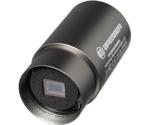
Bresser Full HD DeepSky & Guider 1.25" Color - Reviews
(4)
4 reviews
Info
Reviewbucket.co.uk scanned the internet for Bresser Full HD DeepSky & Guider 1.25" Color reviews.
You can find all Bresser Full HD DeepSky & Guider 1.25" Color reviews and ratings on this page.
Analysis
For Bresser Full HD DeepSky & Guider 1.25" Color, 4 customer reviews collected from 1 e-commerce sites, and the average score is 4.
Detailed seller stats;
Amazon has 4 customer reviews and the average score is 4. Go to this seller.
Detail
Similar Items
Fed-up with faffing around with D-SLR settings and almost impossible focusing on stars and distant objects (DSO's). Saw many pictures by Astrographers using CCD or CMOS digital telescope cameras. Eventually chose this, mainly for price but for performance too as it is a "Deep Space" camera.Of course, first night had to be hazy! Every time you open a new telescope or accessory box clouds escape, float up and block your views! It arrived quicker than planned. In the box, CMOS Camera, USB cable, Guide cable (if you wish to use it as a Guide Scope to control your Go-To Mount) and c-fit extension tube + CD with Drivers and Software. No instructions! For this I remove one star *Bresser products are of pretty good standards,
I do not do many reviews as everyone usually contributes the same experiences and thus, I usually abstain. However, as this Bresser camera only has one review, I felt I should give this wonderful camera a review. So:-Recently bought a new 6inch SCT Telescope and having tried over the years of using my DSLR attached to my former telescope and only being able to view. focus etc on a tiny 2inch DSLR monitor, or using an old 1mp ccd camera and having pictures of an "ok" quality but not deep sky worthy. I read the specs on this Bresser camera and thought I would give it a go.It states "Astrophotography Deep Space Camera". I can concur that is precisely what it is and have attached three photos showing how good this camera really is.
The camera was delivered on time and is well packaged in the original box. The camera itself is well made and appears that it would not break easily. First point is you will need to take time to get used to the software and how it works. If you plan to take images of planets and the moon etc, you will need to purchase a UV /IR filter. The main thing is if you think just attaching this camera to a set of optics costing a few hundred pounds is going to give you hubble telescope images your going to be very disappointed!.Attached to a well collimated light bucket, good seeing conditions, low light pollution with a good standard tracking setup,
